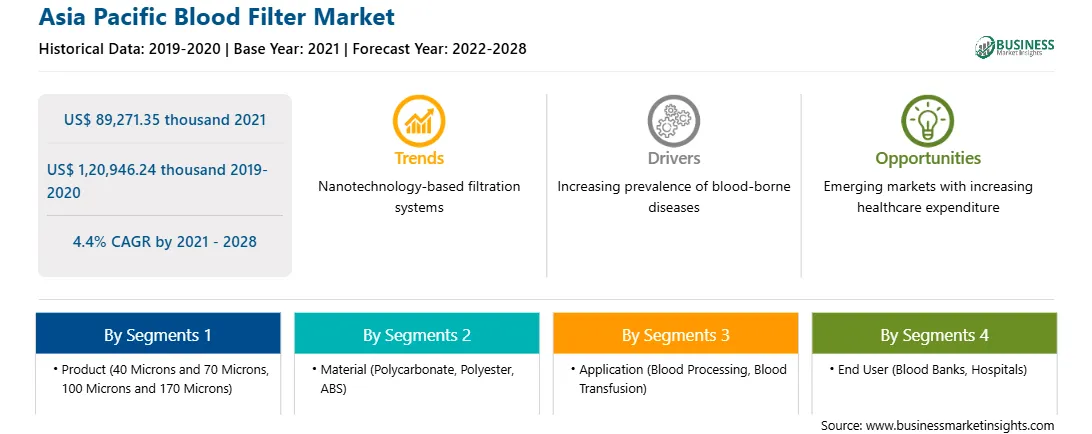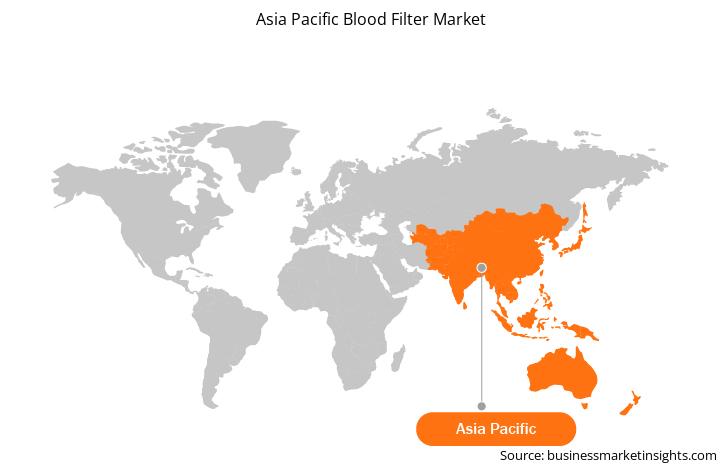Aging population and lifestyle changes are leading to a steady increase in the prevalence of chronic medical conditions. The rapidly growing middle-class population and urbanization are driving the adoption of a sedentary lifestyle. The modernization of facilities reduces physical activities among people, while various personal, professional, and societal factors are adding to their stress levels. Arthritis; cardiovascular diseases, e.g., heart attacks and stroke; breast and colon cancer; diabetes; epilepsy and seizures; obesity; and oral health problems are among the leading chronic diseases reported among elderlies in developed countries. Chronic diseases affect public health, societies, and economies in various countries. Blood filters are widely used in various surgical procedures, such as cardiac surgery and other invasive procedures. Chronic diseases such as cancer, cardiovascular diseases, and renal disorders are the major causes of human death. These conditions are generally treated via surgical procedures, which are associated with a chance of excessive blood loss. Thus, these procedures are followed by the infusion of fresh blood to patients or reinfusion of their own blood. Blood filters are used during the blood infusion or reinfusion processes. Therefore, the Asia Pacific blood filter market is growing with the rapid increase in the burden of chronic diseases.
Currently, there is no proven specific therapy against COVID-19, and multiple novel and repurposed drugs are being used on an experimental basis. The lack of effective therapeutic options has been a major hurdle in pandemic mitigation measures. Studies show that blood filters result in minimizing the effect of cytokine storm created by COVID-19, which causes major organ destruction and may eventually lead to death in serious conditions. Thus, various companies have been initiating their supply process for the availability of blood filters to meet the dire need for the same in APAC. There are a few contender medicines including an antimalarial drug hydroxychloroquine, an antiviral Remdesivir and Ivermectin, and a drug used against worms and other parasites, but the results are not hugely encouraging and at times conflicting. Thus, plasma therapy gained traction as a cure for COVID-19 patients in India in 2020. Further, medical equipment used to conduct apheresis procedure were installed at many hospitals and blood collection centers; for example, GMCH, Thrissur, installed this machine for the first time in Kerala to administer plasma to a 51-year-old man.
Strategic insights for the Asia Pacific Blood Filter provides data-driven analysis of the industry landscape, including current trends, key players, and regional nuances. These insights offer actionable recommendations, enabling readers to differentiate themselves from competitors by identifying untapped segments or developing unique value propositions. Leveraging data analytics, these insights help industry players anticipate the market shifts, whether investors, manufacturers, or other stakeholders. A future-oriented perspective is essential, helping stakeholders anticipate market shifts and position themselves for long-term success in this dynamic region. Ultimately, effective strategic insights empower readers to make informed decisions that drive profitability and achieve their business objectives within the market.

| Report Attribute | Details |
|---|---|
| Market size in 2021 | US$ 89,271.35 thousand |
| Market Size by 2028 | US$ 1,20,946.24 thousand |
| Global CAGR (2021 - 2028) | 4.4% |
| Historical Data | 2019-2020 |
| Forecast period | 2022-2028 |
| Segments Covered |
By Product
|
| Regions and Countries Covered | Asia-Pacific
|
| Market leaders and key company profiles |
The geographic scope of the Asia Pacific Blood Filter refers to the specific areas in which a business operates and competes. Understanding local distinctions, such as diverse consumer preferences (e.g., demand for specific plug types or battery backup durations), varying economic conditions, and regulatory environments, is crucial for tailoring strategies to specific markets. Businesses can expand their reach by identifying underserved areas or adapting their offerings to meet local demands. A clear market focus allows for more effective resource allocation, targeted marketing campaigns, and better positioning against local competitors, ultimately driving growth in those targeted areas.

The Asia Pacific Blood Filter Market is valued at US$ 89,271.35 thousand in 2021, it is projected to reach US$ 1,20,946.24 thousand by 2028.
As per our report Asia Pacific Blood Filter Market, the market size is valued at US$ 89,271.35 thousand in 2021, projecting it to reach US$ 1,20,946.24 thousand by 2028. This translates to a CAGR of approximately 4.4% during the forecast period.
The Asia Pacific Blood Filter Market report typically cover these key segments-
The historic period, base year, and forecast period can vary slightly depending on the specific market research report. However, for the Asia Pacific Blood Filter Market report:
The Asia Pacific Blood Filter Market is populated by several key players, each contributing to its growth and innovation. Some of the major players include:
The Asia Pacific Blood Filter Market report is valuable for diverse stakeholders, including:
Essentially, anyone involved in or considering involvement in the Asia Pacific Blood Filter Market value chain can benefit from the information contained in a comprehensive market report.